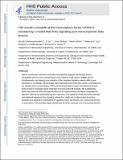| dc.contributor.author | Chitforoushzadeh, Zeinab | |
| dc.contributor.author | Ye, Zi | |
| dc.contributor.author | Sheng, Ziran | |
| dc.contributor.author | LaRue, Silvia | |
| dc.contributor.author | Fry, Rebecca C. | |
| dc.contributor.author | Janes, Kevin A. | |
| dc.contributor.author | Lauffenburger, Douglas A | |
| dc.date.accessioned | 2018-09-10T19:26:10Z | |
| dc.date.available | 2018-09-10T19:26:10Z | |
| dc.date.issued | 2016-06 | |
| dc.date.submitted | 2015-08 | |
| dc.identifier.issn | 1945-0877 | |
| dc.identifier.issn | 1937-9145 | |
| dc.identifier.uri | http://hdl.handle.net/1721.1/117694 | |
| dc.description.abstract | Signal transduction networks coordinate transcriptional programs activated by diverse extracellular stimuli, such as growth factors and cytokines. Cells receive multiple stimuli simultaneously, and mapping how activation of the integrated signaling network affects gene expression is a challenge. We stimulated colon adenocarcinoma cells with various combinations of the cytokine tumor necrosis factor (TNF) and the growth factors insulin and epidermal growth factor (EGF) to investigate signal integration and transcriptional crosstalk. We quantitatively linked the proteomic and transcriptomic data sets by implementing a structured computational approach called tensor partial least squares regression. This statistical model accurately predicted transcriptional signatures from signaling arising from single and combined stimuli and also predicted time-dependent contributions of signaling events. Specifically, the model predicted that an early-phase, AKT-associated signal downstream of insulin repressed a set of transcripts induced by TNF. Through bioinformatics and cell-based experiments, we identified the AKT-repressed signal as glycogen synthase kinase 3 (GSK3)-catalyzed phosphorylation of Ser37on the long form of the transcription factor GATA6. Phosphorylation of GATA6 on Ser37promoted its degradation, thereby preventing GATA6 from repressing transcripts that are induced by TNF and attenuated by insulin. Our analysis showed that predictive tensor modeling of proteomic and transcriptomic data sets can uncover pathway crosstalk that produces specific patterns of gene expression in cells receiving multiple stimuli. | en_US |
| dc.publisher | American Association for the Advancement of Science (AAAS) | en_US |
| dc.relation.isversionof | http://dx.doi.org/10.1126/SCISIGNAL.AAD3373 | en_US |
| dc.rights | Creative Commons Attribution-Noncommercial-Share Alike | en_US |
| dc.rights.uri | http://creativecommons.org/licenses/by-nc-sa/4.0/ | en_US |
| dc.source | PMC | en_US |
| dc.title | TNF-insulin crosstalk at the transcription factor GATA6 is revealed by a model that links signaling and transcriptomic data tensors | en_US |
| dc.type | Article | en_US |
| dc.identifier.citation | Chitforoushzadeh, Zeinab et al. “TNF-Insulin Crosstalk at the Transcription Factor GATA6 Is Revealed by a Model That Links Signaling and Transcriptomic Data Tensors.” Science Signaling 9, 431 (June 2016): ra59 | en_US |
| dc.contributor.department | Massachusetts Institute of Technology. Department of Biological Engineering | en_US |
| dc.contributor.mitauthor | Lauffenburger, Douglas A | |
| dc.relation.journal | Science Signaling | en_US |
| dc.eprint.version | Author's final manuscript | en_US |
| dc.type.uri | http://purl.org/eprint/type/JournalArticle | en_US |
| eprint.status | http://purl.org/eprint/status/PeerReviewed | en_US |
| dc.date.updated | 2018-09-10T14:08:15Z | |
| dspace.orderedauthors | Chitforoushzadeh, Zeinab; Ye, Zi; Sheng, Ziran; LaRue, Silvia; Fry, Rebecca C.; Lauffenburger, Douglas A.; Janes, Kevin A. | en_US |
| dspace.embargo.terms | N | en_US |
| dc.identifier.orcid | https://orcid.org/0000-0002-0050-989X | |
| mit.license | OPEN_ACCESS_POLICY | en_US |
